Matador Network's Blog, page 2249
June 30, 2014
Latin America's hottest new music
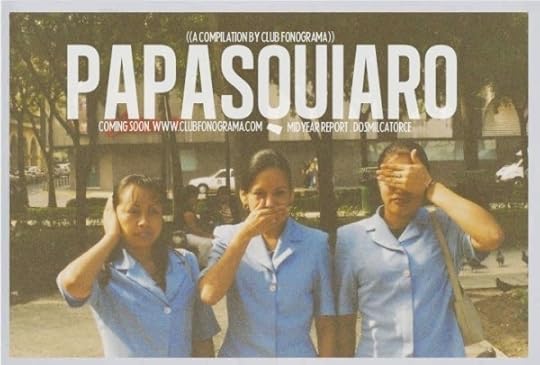
Carlos Reyes has been blogging since he was 14. Exactly two years after his family migrated from Mexico to Phoenix, Arizona. There’s nothing coincidental about this — coming to America was an exercise in profound dislocation and loneliness. Blogging was his way forward.
Club Fonograma, the music site he founded six years ago, has become a digital mecca for Latino hipsters, Anglo hispanophiles, and music lovers. The blog features music exclusively in Spanish, but all reviews are written in English. In that way, his creative effort closely parallels his own life: half spent in Mexico, half in the United States.
It’s been ages since Club Fonograma released a new compilation. The site’s mixtapes are widely loved and distributed. The Covers Mixtape, released in 2010, was downloaded 80,000 times.
Papasquiaro, as in Santiago de Papasquiaro — the name of Reyes’s hometown in Mexico — dropped on June 9. It’s composed entirely of new tracks by some of Latin America’s most experimental artists. Chilean pop prince Gepe recorded a 50-second song on his iPhone as a favor to the music site. The Mexican group Capullo threw down an upbeat masterpiece called “Orientación Vocacional.”
All of the tracks may be new, but something suggests that this mix is about nostalgia for a lost past, as if Reyes were asking his followers: What if I had never left Mexico? 

Global recipe infographic
ONE ADVANTAGE OF renting an apartment while traveling, is that it provides me with a place to cook. I then go out to the local market and pick up fresh ingredients, especially spices. Those plastic-encased piles of dust I get in my hometown supermarket are really no match for freshly ground, or just-been-picked flavors, and trying to recreate dishes back home in the USA is usually really disappointing. This infographic is my new favorite thing though – I don’t have to get all fancy and complicated with my cooking, just add three of these ingredients to anything I make, and I’ve become an instant international chef.
Let the baller dinner parties commence! (click to enlarge) 
Infographic via The ShortList

Buenos Aires after midnight

Image: Francisco Lurcovich
1. Take a walk
Not through Villa 31, please, unless you have some sort of Fight Club wish to get your gringo ass beaten and/or robbed. Instead, head over to the Reserva Ecológica Costanera Sur (Ecological Reserve). This 865-acre park is a quiet and pretty safe place to stroll, bike, or enjoy a bottle of Malbec while taking in the skyline.
2. La Noche de los Museos (Night of the Museums)
For one much-anticipated night every November, BA’s museums, universities, and artistic spaces open their doors for free from 7pm to 2am and host films and performances of jazz, tango, folk, techno, choral, and rock music. Hundreds of thousands of people attend, and the night usually ends in a massive street party. Leave it to Buenos Aires to find a way to combine culture and la joda so well.
3. Florería Atlántico
Okay, so it is in some way a Recoleta speakeasy, but it makes the list anyway for being so much more. A charming flower and wine shop up front, you then pass through a refrigerator door into a subterranean chamber, where late into the night you can enjoy a coffee or a cocktail in an environment that could not get any more tranquilo.
4. Skate (or be a poser)
Over the last few years, Buenos Aires has taken huge strides toward becoming a premier city for skateboarding. Check out these free skate parks where there will be no mala onda police officers or cranky neighbors messing with you: Plaza Houssay, La Rural, Parque Centenario, Converse Skate Plaza (Norte), or Converse Skate Plaza (Mataderos).
At night, some of the roads north of the city, such as in the neighborhoods of Olivos or San Martin, are relatively traffic-free and are ideal for longboarding.
5. People watch
Buenos Aires is full of all types. Sit along the wall of Plaza Dorrego and watch the people coming and going. You can expect everything from makeout sessions to beggars to kids playing at all hours, and you may even be treated to impromptu street music.
6. Graffiti
Buenos Aires has some of the most vibrant street art in the world, with a vast array of murals by internationally renowned artists like Jaz and Pum Pum. Best to get permission to paint someone’s privately owned wall…and do the world a favor and please paint something more creative than just your name in ‘wannabe gangsta’ style.
7. Tango lessons
Step it up from just watching the show — become part of it. Many milongas offer lessons well into the wee hours of the morning. Learn a thing or two early in the night, and put it to practice until dawn at one of the many milongas scattered throughout the city.
Etiquette is huge at La Calesita. Men and women are seated on opposite sides of the room, and snagging a partner involves an intricate code of subtle nods and eyebrow twitches. Several milongas welcome novices — try Tango Cool, La Viruta, or La Marshall.
8. Hop on a local bus for a cheap city tour
A couple of pesos will get you all around the city at a time when there isn’t much traffic, and can more safely show you parts of the city you probably have no business walking through at night. The 23, 26, 46, 70, and 76 all go through villas. Slightly safer, though arguably more predictable and boring, would be the 152 between Retiro and La Boca where you can see the back of the Casa Rosada and the English Tower all lit up by night.
9. Telos
Simply put, a telo is a sex hotel, rented by the hour. Ranging from the fantastically tacky to full-on luxurious, they are all over the city. Frolick on a waterbed under a mirrored ceiling (although, seriously, you can get more creative than that).
Go to Los Jardines de Babilonia to play out Julius Caesar fantasies you may not have known you had. Be Jabba the Hutt to your tied-up Princess Leia in the Star Wars room at Rampa Car, or if you’re not sure how creative your partner wants to be, go classy and clean at Del Bosque. Even the most high-class telo won’t run you more than $60 an hour, and some will only cost you about $10.
10. Swingers clubs
Just for fun, let’s throw out the idea that you might be interested in one-upping the telo idea. Buenos Aires has a couple of swingers clubs, just saying, including the multi-level Anchorena and the slightly seedier Reina Loba. Whether you want to participate (no judgment here) or just go and watch (think of it kind of like a live art exhibit, if that makes your horny / curious–yet-guilty conscience feel better). Your night is bound to at least be more interesting than a night at home with pizza delivery and Netflix.
11. Dinner
Yes, this is an article on things to do after midnight. And yes, dinner is well within the possibilities. Get the idea of dining at 6 or 7pm right out of your head — most places don’t even open until 9pm, and if you show up that early you’re likely to be the only person seated.
Whether you’re trying out a new restaurant or are invited to a friend’s house for an asado, don’t be surprised if dinner goes on until well after midnight. After all, this is BA and you need to be fueled up for whatever the long night holds. 

4 theories on Americans and soccer
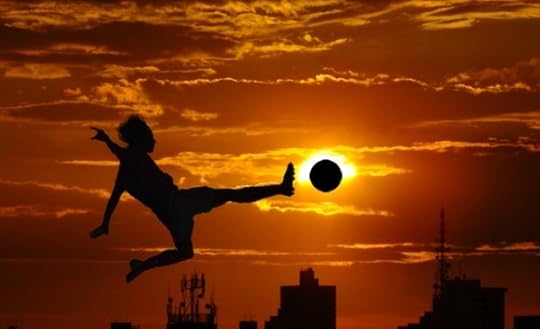
Photo: Rama V
We Americans love our sports. Huge chunks of the country tune in for the Super Bowl, even though the vast majority of us couldn’t give a shit about either team, and even though the vast majority of us have no desire to see a halftime show with Bruno Mars. We even watch baseball and golf on TV, as if they were summertime yule logs — only way more boring.
So why, unlike virtually every other country on the planet, hasn’t the US picked up soccer? Here are some theories.
1. The “corporations won’t let us” theory
When you ask Americans why they won’t watch soccer, the answer is usually that they find the sport boring. “Why would I watch a game where the score can be 0 – 0 at the end?” This would be a fair point if America’s national sport wasn’t baseball. Baseball is excruciating to watch. It’s literally just a bunch of men running in circles for four hours, only for 95% of that time, they aren’t running in circles. The reason soccer ends after 90 or so minutes is because soccer fans have things to do and can’t hang out in the stadium for five extra innings. It’s because they know when to say, “Ah, fuck it, let’s just finish the game and go out drinking.”
Also, the “boredom” excuse is pretty subjective. In soccer-loving countries like the UK and Argentina, I’ve had people tell me they find American football boring. Usually, this is more because they don’t fully understand the rules and strategy, so they can’t identify an incredible play when they see it. The same is true of uninitiated American fans with soccer. It’s not a matter of the game being “boring” — it’s a matter of understanding the game.
What do you need to understand a sport? Time with it. How do you get time with it? It gets on TV.
This is the most interesting theory I’ve heard: American television networks would rather put baseball and American football on TV because those two sports have constant, frequent breaks during which they can show commercials. Soccer, on the other hand, requires 45 minutes of uninterrupted television. You could see five commercial breaks during an American football game in that period of time.
Sure, you can put ads on the fringes of a soccer pitch, but there’s no guarantee fans are going to notice them. You can’t avoid seeing a Geico ad during an American football game. And soccer, unlike in Europe and South America, wasn’t big in the US before the advent of TV, so networks have no real incentive to air much soccer. Why do that when you can make way more money on baseball?
2. The “Americans don’t have the attention span” theory
This one I think is kinda bullshit, but let’s consider it for a second. Americans are, it must be admitted, an easily distracted crowd. They like to know when they need to pay attention, and American sports accommodate them in that way: “Hey guys, the Cowboys are in the red zone! Come back to the TV!” or “Hey guys, Pujols is on third base!” or “Hey guys, this is basketball! Someone’s going to score every 30 seconds for the entire game!”
Soccer, on the other hand, is much slower in the way of scoring. Goals are a much less frequent occurrence and come after a slow, anxiety-ridden build up. There are plenty of near misses. There are plenty of “awwws” running through the crowd. This isn’t how we’re used to our sports working. It’s too easy to miss what’ll possibly be the only goal of the game. We don’t deal with frustration well here in America, and the frustration of possibly looking away for 10 seconds and missing the highlight of a 90-minute game is too much.
Again, I think this is a matter of misunderstanding the game more than anything else. What’s striking when you get to know soccer is not the scoring, necessarily, but the skill of the players — how deftly they handle the ball, how seamlessly it moves between them, how precisely they can hit a teammate from down the field. There’s more of a fluid team element to it that I think Americans, given their love for other major team sports like football and hockey, could totally get into with a better understanding and more spectating experience.
3. The “soccer players are prima donnas” theory
Soccer players have a tendency to do two things Americans aren’t big fans of:
1) They take dives.
2) They wear hair products during the game.
The first of these is fair. Soccer players do tend to milk their injuries or straight-up pretend they have injuries, which chafes against American ideas about fair play. But as a friend pointed out, “They foul all the time in basketball, but it’s only worth two points, usually. That’s, like, two percent of the total points that’ll be scored during the game. You can afford to look like the bigger man in that case. In soccer, in the right circumstance, a foul can mean a goal, which is anywhere from 20% to 100% of the points scored in the game. See how many basketball players start milking their fouls when that’s the case.
And I can’t defend the hair. Americans are weird about their machismo. We’d just have to get used to that.
4. The “America has other sports” theory
“Eh, I’ve just got too many sports on my plate already,” said no one ever. Sports aren’t like Game of Thrones. You don’t ever need to “catch up” by watching every game that’s been played. They all stand by themselves.
But Americans do have a number of other major sports they watch pretty constantly: football, baseball, basketball, hockey. These can fill up a year if you like all of them. But most people don’t, and a lot of people would be more than happy to have another sport to distract them from real-world worries.
I think soccer is on the rise in America. I think more people I know are watching Premier League games and the World Cup than ever before. But I’m an American, delusionally optimistic to the last. 

In defense of the selfie
THE SELFIE is a ubiquitous part of 21st-century Western culture. Oxford Dictionaries unanimously chose the term as the 2013 Word of the Year, while the BBC and Guardian continue to run stories about selfies. Even President Obama has jumped in on the action, taking a selfie at a funeral. Yet despite the cultural pervasiveness, the selfie gets a bad rap. It’s a gesture of vanity, of self-importance, of selfishness, of narcissism.
Or is it?
Capturing a self-portrait is not an inherently corrupt act — nor is it a new endeavor. Since the advent of mirrors, painters and sculptors have tinkered with various forms of self-representation. The photographic self-portrait is also nothing new. An American chap named Robert Cornelius was a pioneer in the domain of photography, and in 1839 he captured what is believed to be the world’s first known selfie. Self-portraiture (and the selfie) is old business.
Maybe it’s dangerous to admit, but I am a fan of the selfie. I decided to use the medium to help share a journey of mine: one year traveling around the world. But why use the selfie as a medium of recording? Well, I started journaling at the age of 17, and since then I’ve morphed into something of a “documentist.” Over the past 15 years, journaling has been a simple way of tracking both the practical and emotional details of my life. What adventures am I up to? Who am I spending my time with? What am I feeling? Writing has always been my way of processing the world I live in. The process of documenting your life, however, doesn’t have to be limited to the written form; with photo and video, we are also able to observe our lives in ways that previous generations could never have imagined.
With this in mind, before I left for my yearlong journey I made a few documentation goals: to write a weekly letter home, to produce a daily video, and to capture a daily selfie. In a way, the routine of taking a self-portrait was not just a way of recording the journey, but also a technique for measuring the effects of long-term travel on the face of the traveler — essentially, I wanted to see how travel would look on me. By the end of the year, I had accumulated not just a monstrous beard, but also a collection of nearly 500 selfies (as some days I took more than one photograph).
The selfie enables us to communicate a simple yet human sentiment: “This is me. In the world. I am here.”
These images, when stacked one on the next, work well as a sort of stop-motion video, a fast-paced glimpse into a year of international adventuring. If you pause the video at certain points, you’ll observe a couple of notable changes. Upon arrival to Buenos Aires, for example, I had an unfortunate incident where mosquitoes ravaged my face — you can see the bumps of bite marks across my forehead. As the year progresses and I move through various countries, you’ll also notice I become more tanned. I get different hats. I lose weight. And then, of course, there was that beard. Together, the 365 photos tell an abbreviated story of one person’s journey in a method that lends itself to our collective 21st-century attention spans.
But my goal is not simply to cater to our internet-ish attentiveness. I believe there is a direct relationship between the selfie and solo travel. They are both, by definition, solitary endeavors. Although I made new friends as I traveled around the world, I was more or less on my own for an entire year. In some instances, I would request that someone else — a local or a fellow tourist — use my camera to photograph me. But often I didn’t. Why? Because rooted in the mission of any solo traveler is the quest for a certain amount of autonomy.
In this regard, could it be that the selfie used while travelling alone is an act of self-sufficiency? The gesture of capturing a selfie next to Inca ruins or a Himalayan mountain might just be a mild personal expression: “I am out here, exploring the Earth on my own, and I am functioning just fine.” And if that were the case, would we despise the selfie any less? Could the selfie be a valid form of documentation? Could it be a legitimate method of photographic journaling? And, most importantly, could it even be an expression, a celebration, of autonomy?
If so, then it’s time to expand our perspective on the loathed selfie. Instead of being a modus of narcissism, perhaps the selfie is also a modest medium that enables us to communicate a simple yet human sentiment, something that Robert Cornelius surely sought to express through his first photographic self-portrait: “This is me. In the world. I am here.” 

40 best travel-themed tattoos [pics]
Sometimes, you get home and you just feel like you need to commemorate the trip with something more than a photo album on Facebook. Sometimes, the trip seems to have sunk so deep into who you are now that it makes perfect sense to have it etched into your skin.
I’ve actually never gotten a tattoo of any sort, though after my first trip abroad I got as far as sitting in the artist’s chair — when he informed me he was insanely hungover, maybe still drunk, and then said, “Okay, shake it off. Let’s roll.”
I told him I was having second thoughts and would come back later and never did. And I’m glad I didn’t. My idea wasn’t all that great, and if you’re gonna get a tattoo of something, you should really think it through and be 100%. There are thousands of pictures of travel tattoos out there on the internet. Here are some of the coolest I found. 
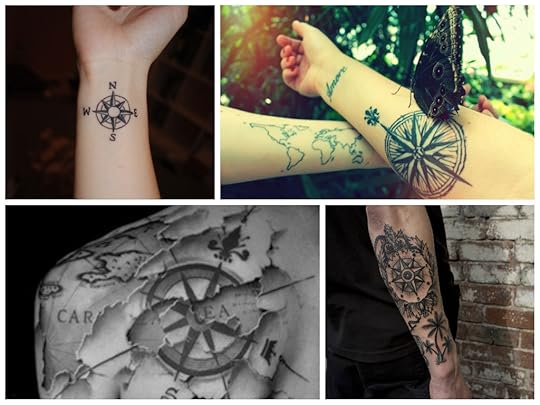
1
Compass
The compass is a common theme. It can range from as simple as the basic compass-on-the-wrist in the upper left-hand corner, to the incredibly complex, as in the bottom left.
(via, via, via, and via)
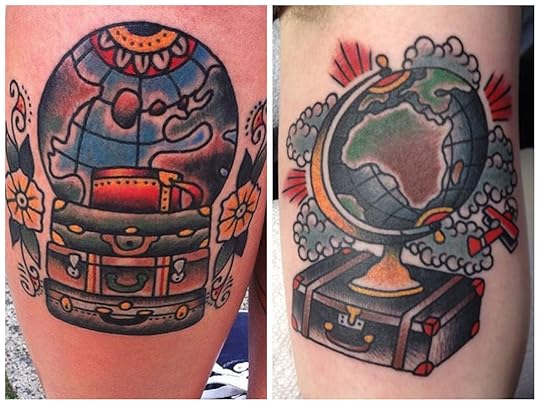
2
Globe suitcase
I’m a fan of the globe on the suitcase design. It looks like, if these weren’t done by the same artist, then one was done with the other in mind. Either way, it’s a good look.
(via and via)
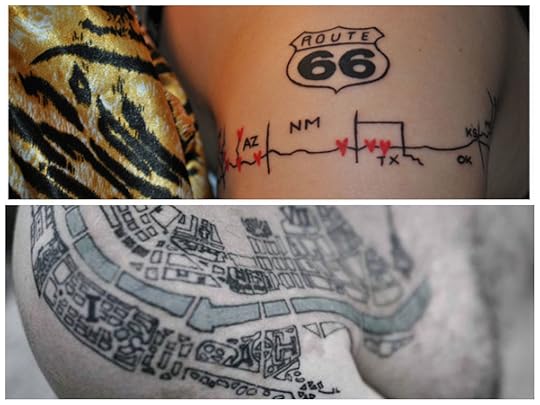
3
Route 66 and Paris
Maps of countries seem to be fairly common, as do skylines of favorite cities, but I actually saw relatively few maps of cities. These were two of the better I found. I couldn’t help but wonder what each of the hearts stood for on the Route 66 tattoo (maybe the cities named in the song?), and the Paris tattoo is just beautiful.
(via and via)
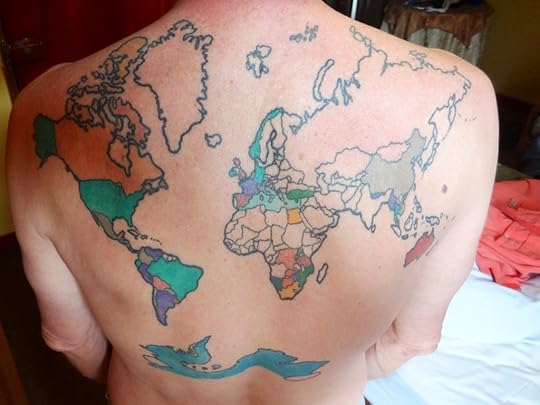
4
Fill-it-in-as-you-go
This guy made headlines a little while back for getting the world map tattooed on his back and then filling in the countries he visits as he goes to each of them. Even though this is an undoubtedly awesome tattoo, I feel bad for the guy after he goes to Russia.
(via)

5
Coordinates
The coordinates of some special place are another fairly popular idea, though this doesn’t necessarily need to reflect travel. It could be home, or the place that something important happened, or possibly a map to treasure.
(via and via)

6
Nautical tattoos
Anchors and ships are another fairly popular theme.
(via, via, via, and via)
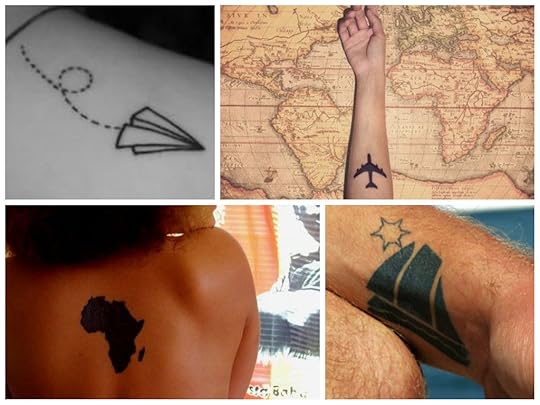
7
Minimalist tattoos
I’m a big fan of the minimalist tattoo done well. I also think the paper airplane is about the perfect symbol for the concept of wanderlust, which is one of the most common words I was finding on travel tattoos.
(via, via, via, and via)
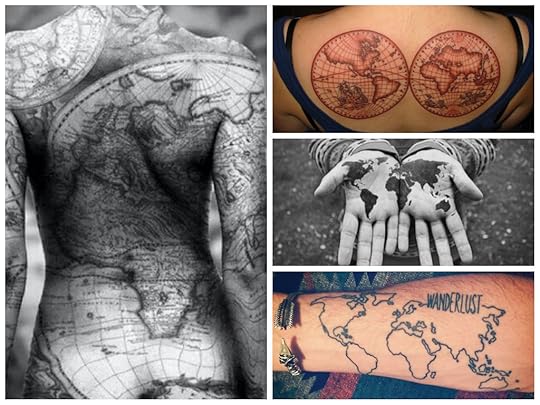
8
Maps
Obviously, world maps are ubiquitous. But there’s an infinite amount of variety and complexity to how you can do them.
(via, via, via, and via)

9
Free bird
Another great symbol is the "free bird." Though this doesn’t necessarily denote travel, it signifies a state of mind compatible to travel.
(via, via, via, and via)
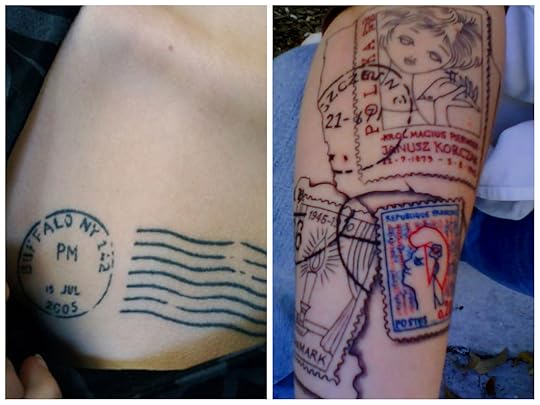
10
Stamps
A postage stamp / postmark would be a great way to represent your hometown or a place that’s particularly close to your heart.
(via and via)
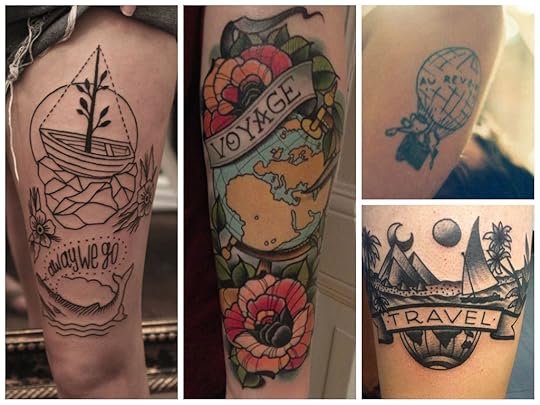
11
Voyage
The creative image-based ones typically involve a globe or a vehicle with a token word or two.
(via, via, via, and via)
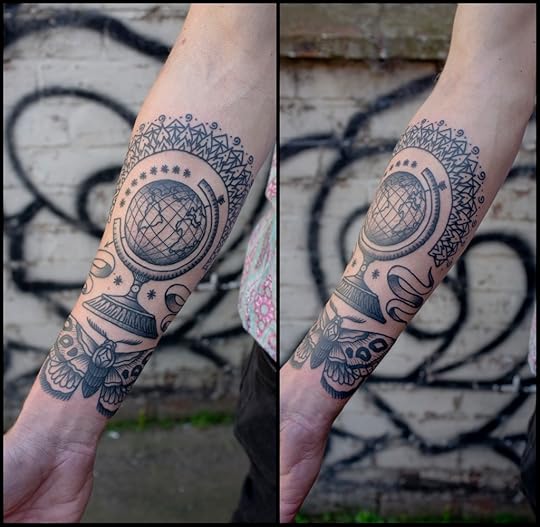
12
Globe mandala
This globe mandala is one of my favorites. You could alter the specific design according to your own experiences.
(via)

13
Foot tattoos
For those who may not want large tattoos on prominent parts of their bodies, foot tattoos may be an understated alternative. All you need to cover them up are socks.
(via, via, and via)
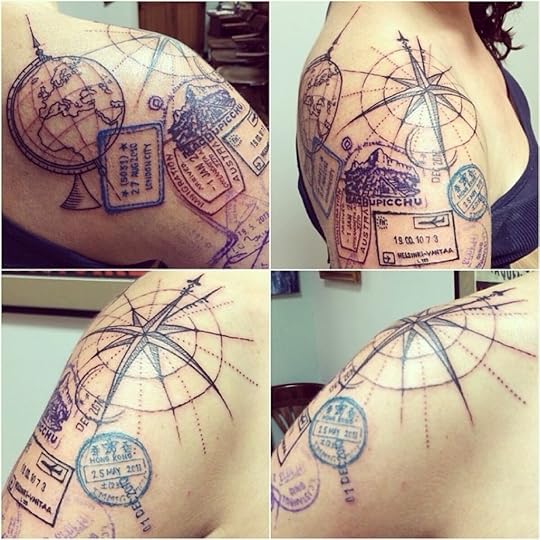
14
Passport stamps
This is the best on the passport stamp theme. I have at least four of these stamps in my own passport.
(via)
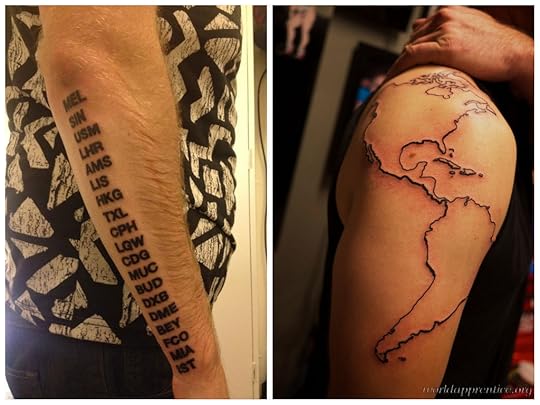
15
Arms
Personally, I have no desire to commemorate the airports I’ve been to. Airports are almost universally a miserable experience. But it’s another cool ongoing list.
(via and via)
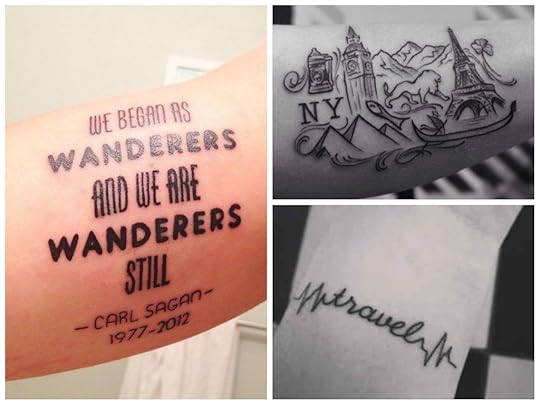
16
Wanderers
I’m not a big fan of quotes or words on tattoos. It’s a visual-art medium, so in my opinion pictures are preferable. That said, not everyone gets tattoos for the art. Sometimes they just need to be reminded of something.
(via, via, and via)
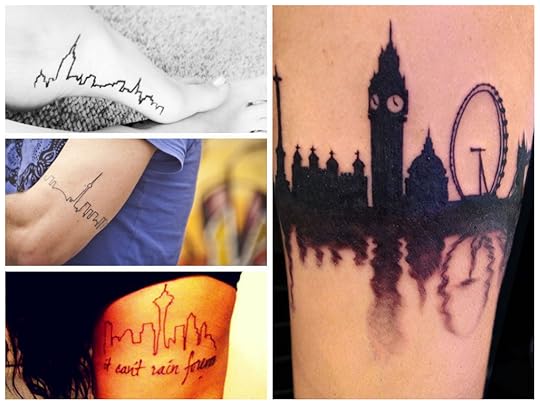
17
Skylines
Skylines are a trendy choice, and you can find them for virtually any city with a remotely distinctive skyline.
(via, via, via, and via)
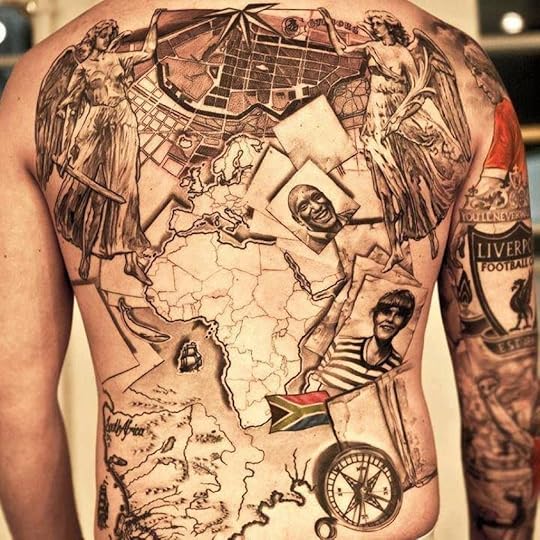
18
The "everything"
Of course, if you’re having trouble picking between all your options, you could just get your entire life tattooed on your back and arms.
(via)

June 29, 2014
A vid for climate-change skeptics
One of the more frustrating ‘arguments’ we hear from climate change skeptics is: “It’s cold outside today! Guess that disproves global warming!”
While often this can feel like an intentional misunderstanding of the facts, it can also be somewhat hard to argue against if you’re not a climate scientist. Yeah, this past winter was pretty chilly and snowy here on the East Coast. Fortunately, we have scientist, media personality, public intellectual, and giver-of-lady-boners Neil deGrasse Tyson to explain it for us.
Using a wandering dog on a leash, Tyson explains the difference between “weather” and “climate.” While weather can vary significantly and refers to much shorter time spans, climate deals with patterns and trends over a long period of time.
Check it out, and post it in the comments of the next person who posts something about how a snowy day disproves what 97% of climate scientists totally agree on. 

Inside a legal brothel in Nevada
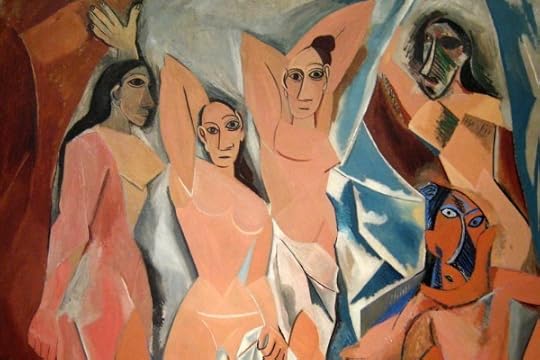
Pablo Picasso’s Les Demoiselles d’Avignon. Photo: Wally Gobetz
TO BE HONEST, six days after getting engaged was not the time I would have picked for my first trip to a brothel. But a relationship has to be built on trust, and my fiancée had to trust what I’d promised her: “I swear to god, I will not touch a single. fucking. thing.” And this is a promise I kept, unless you count those two seconds I unwittingly leaned against the forced masturbation chair.
I was in southern Nevada on a press trip with Travel Nevada to research “the ultimate bachelor party.” Most of the itinerary was just doing baller, awesome stuff like firing a machine gun or racing a Porsche or taking a helicopter over the Grand Canyon, but one item on the itinerary was an hour-long tour of Sheri’s Ranch, one of Nevada’s 19 legal brothels. When I told my fiancee’s parents about the trip, I left this item off.
The reason — other than I don’t want them to think their future son-in-law is a sleazeball — is that I have mixed feelings about legalized brothels. As far as I can tell, there were four voices simultaneously arguing in my head on the drive there: the prude, the teenage boy, the feminist in favor of legalizing prostitution, and the feminist against legalizing prostitution. Here’s a snippet of the conversation:
Feminist in favor: “Shouldn’t they be allowed to do what they want with their bodies? And doesn’t this provide a safe venue for them? Isn’t it a form of empowerment?”
Feminist against: “If you think there’s no abuse happening just because it’s legal, you’re deluded. Also, what does it say about our society that all we value about women is their bodies?”
Prude: “Guys, what if everything is covered in syphilis? Also, how does syphilis work?”
Teenage Boy: “OH MY GOD, WHAT IF I SEE BOOBS?”
Nevada: The “Pay to Play” State
Brothels in Nevada have been legal for over 100 years. Counties still get to choose whether to allow them or not, and they’re not legal in Las Vegas, Reno, Carson City, and a few other places. All prostitution has to take place within these legalized, regulated brothels. The women who work at Sheri’s Ranch told me they’re kind of like contractors — they pay a fee to the brothel to stay there and use the premises, they pay for a sheriff’s card (which is basically a work permit that’s renewed quarterly or whenever they change brothels), they pay for the weekly STD testing, and they pay taxes. As contractors, they don’t get benefits.
The ten largest cities in the state are all in counties that don’t allow brothels, so they tend to be out in the middle of nowhere, and there are differing levels of pay at each — the ladies negotiate their rates themselves based on the amount of time and what you want to do — but the most expensive brothels are the ones closest to Vegas. Sheri’s Ranch and another brothel called Chicken Ranch are in a small town about an hour and a half outside of Vegas, right near the California border, called Pahrump, which the teenage voice in my head thought sounded like a hilariously onomatopoetic sex noise. They are generally the most expensive in the state.
Sex dungeons, corporate sponsors, and lineups
When you first walk into Sheri’s Ranch, you’re probably walking into the bar. The bar looks like any other dive bar in the country. It has autographed footballs and jerseys by the likes of Joe Montana, Joe Namath, Walter Payton, and Larry Johnson in a display case above the taps. TVs play ESPN in the background. And a few customers will look very disturbed to see a flock of 14 journalists coming through the door.
We’re met by Cassie and Arianna, two ladies who work at Sheri’s. Both tend to favor the term “ladies” when they speak of themselves or their coworkers. When one of our group asks what they prefer to be called — prostitutes, whores, escorts — Cassie says she doesn’t care, and Arianna says she prefers to be called an entertainer. Or Arianna. Cassie, the blonde in a skin-tight black dress with a number of tattoos, does most of the talking, while Arianna, in a tight leopard-print dress, hangs back and answers occasional questions. Offhand, Cassie says the two of them are getting married at the end of the summer.
As we’re about to start the tour, an older woman who says she’s the Madam walks up to one of our Travel Nevada guides. “Still just a tour, right?” she says.
AHHHHHHHHHHH! the teenage boy screams in my head.
“Yeah,” our guide says. “We gotta go in about an hour.”
“Okay, the Madam says. “You guys are free to hang around for drinks, though.” And she leads us out of the bar.
A set of velvet drapes separate the neon-lit bar from the bright, marble lobby. There’s a couch, and then sliding glass doors looking out to a grassy courtyard and a pool where “bottoms are required.” This, the Madam tells us, is the lineup room. If they ring a bell, the ladies have to be ready in a few minutes, and come line up for the customer. The customer picks one or more ladies, and then they negotiate the price, he or she pays, and then the lady fulfills her end of the bargain.
“Different ladies will do different things,” Cassie says. Most of what they discuss is themed. There’s a room decorated like a classroom, they tell us, and also like an office. A sign offers a “geisha” experience. We don’t see those — some are “in use.” Instead, they take us to the harem bungalow, then to the African bungalow, then to the Landshark Room with the hot tub and the Landshark surfboard on the wall. Oh yeah: Sheri’s Ranch is, according to the Madam, the only corporate-sponsored brothel in the country. Thanks, Bud Light!

The last room we visit is the S&M room. “A second lady is always required to be in this room with the customer,” Cassie says. I enter the room last, and lean against a chair in the corner, assuming it’s where the chaperone sits. Cassie starts pointing to contraptions in the room and telling us their names, but I honestly don’t remember any of them, because then she pointed at me and said, “And that’s the forced masturbation chair.”
PURELL! PURELL! the prude shouts. I clear my throat and shift away.
The Sex Menu: “Different, but so good”
Every room has a sign that says “CONDOMS ARE MANDATORY,” and different rooms have different features and fees. Depending on what you want to do with how many ladies, the cost will run you anywhere from $1,000 an hour to $20,000 an hour and up.
What they’ll do? Well, it’s all on the Sex Menu, of course, which you can read on their website, with descriptions. (That link is like crazy NSFW, by the way.) Some of the options include a Half and Half, which is a blowjob and sex (“in a warm, silky glide!”), a Cold Blowjob (“different, but so good ice cold blowjob experience!”), a Hot and Cold Blowjob (“you will not know whether you are going or cumming!”), and a Tongue Body Licking Massage (“Erotic Sex Tongue Pleasure!”).
Blowjobs, like all other sex at Sheri’s and anywhere in Nevada, are becondomed blowjobs. “There is no transfer of bodily fluids. Period,” the Madam says. If you’re tuckered out after your time with the ladies, you can stay in the adjacent hotel, and in the morning, you can grab breakfast in the dining room, stop in the gift shop for a souvenir, and then head home.
The loudest voice in my head
The place, it has to be admitted, leaves a good impression. It seems relatively safe for the ladies, compared to, I would imagine, working for a pimp, and the premises seemed hygienic for a brothel. But it’s a brothel, and maybe this was the work of the teenager or the prude in me, but I just couldn’t fight off the psychic feeling that there was a film of something desperate and sleazy on all of the walls.
When I got home, of course, some research proved that feeling right. As nice as Sheri’s Ranch makes legalized prostitution seem, it’s still a risky business: There are still a ton of reports of abuse, and many of those in favor of legalized prostitution don’t want the system currently in place in Nevada, which benefits the brothel owners and the customers more than the prostitutes themselves. And sex trafficking (and thus slavery) is still a thing in Nevada.
So I’m not for this type of legalized prostitution. There’s probably a system that could work, but Nevada’s isn’t it. The problem with getting into discussions about sex policy, though, is that it’s hard to talk reasonably when the loudest voice in most people’s heads is the teenage one: giggling hysterically at words like “Pahrump” and imagining the wallpapers are made of syphilis. 

June 28, 2014
Science says you aren't alone [vid]
In our darkest moments, we can often feel painfully alone in the universe. It’s a horrible feeling to have at the worst of times, but, fortunately for us, science says it’s bullshit.
Kurzgesagt, a YouTube channel that’s basically a real-life version of The Hitchhiker’s Guide to the Galaxy, has put together this excellent video on how, on a genetic and atomic level, we aren’t remotely alone, but rather are deeply and fundamentally connected to everything else in the universe.
While this may not be the type of “alone” you’re thinking about in the dark moments, it may offer you some comfort — you aren’t separate from anyone or anything, and nothing will ever change that. It’s pretty rare that science is this comforting, so let’s take it while we can get it. 

18 crazy waterslides [pics]
GROWING UP IN THE NEVADA DESERT, nothing cut through the 110-degree stupor like a family outing to Wet and Wild, the local water park. Despite my debilitating fear of heights, precious few things kept me from trudging up the trillions of stairs, looking down, and immediately regretting my decision before being forcibly pushed into the tube by the burly guy regulating human pileups. It was all worth it for the rush of shooting out the bottom of the slide, flying a few feet, and performing a spectacular belly flop into the pool below.
But as I’ve grown older, the slides have seemed smaller, the ride less an epic adventure and more a soggy disappointment — so after my last sad, wet journey to some tiny water park in the middle of nowhere, I vowed to find a slide that lived up to the excitement, the fear, and the joy of my childhood.
Here are 18 of the world’s most insane, epic, and terrifying waterslides. 

1
Scorpion’s Tail - Noah’s Ark Waterpark, Wisconsin
The Scorpion’s Tail at Noah’s Ark Waterpark is a frightening waterslide, with its huge loop and clear plastic tubing. Adding to the intimidation factor is the entrance to the slide—rather than sliding into the tube on your ass like a normal waterslide, you step into a vertical capsule and the floor drops out beneath you with no warning whatsoever. You immediately drop TEN STORIES before entering the loop at roughly 50 feet per second, and you’re done with the 400-foot-long slide in six seconds flat. Holy shit.
(Via)
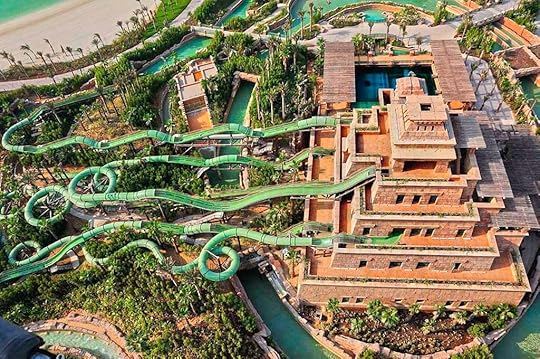
2
Master Blaster - Atlantis The Palm Resort, Dubai
These slides are actually kind of beautiful, which is pretty unusual for waterslides. Each of the four slides starts from a different level of a Mayan pyramid, and shoots riders off all over the park. The big feature of Master Blaster coasters (which seems to be more of a brand than a ride name) is their powerful streams of water that actually propel riders uphill. And as if all that wasn’t cool enough, the whole park is located on the Palm Jumierah—the man-made island formation in the shape of a date palm.
(Via)
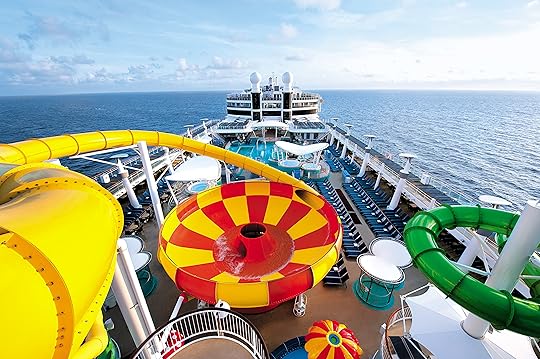
3
Epic Plunge - Norwegian Cruise Line
This one is double cool, because not only is it an epic waterslide, but it’s also on a boat. Yep, one of the best waterslides in the world is on a ship belonging to the Norwegian Cruise Line. The slide extends over almost half of the ship’s length before dropping riders down into a huge bowl and eventually ejecting them into a top-deck swimming pool.
(Via)
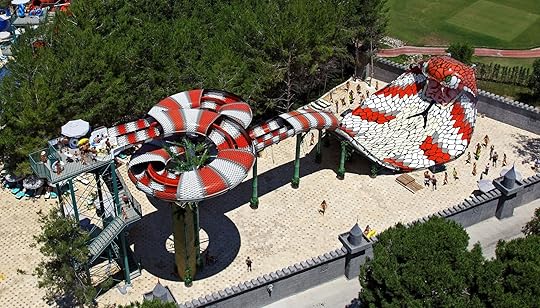
4
King Cobra - Six Flags, New Jersey
If you lined up the pictures of every slide on this list and told me to choose “the one,” the King Cobra would be my pick every time. Though it’s only about 60 feet tall, the Cobra is a one-of-a-kind raft racer, where riders hurtle through the snake’s coils and shoot down a huge drop before flipping up into its mouth. The raft then slides back and forth in the gigantic half-pipe until finally coming to a stop at the base of the animal’s hood. The winner of the race is well-rewarded, too, because the faster you’re going, the further you’ll be able to fly into the mouth of the beast.
(Via)
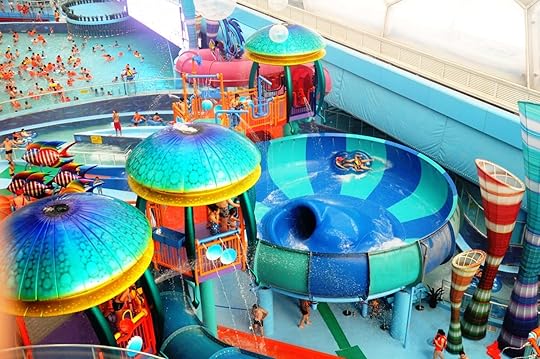
5
Bulletbowl - The Watercube, Beijing
The Beijing National Aquatics Center, constructed for the 2008 Summer Olympics, is known to the locals simply as “The Watercube,” and if you’ve ever seen it, it’s pretty obvious why. But since the Olympics, the Watercube has undergone massive renovations, and rather than a series of Olympic swimming and diving pools, it now contains a huge water park. The Bulletbowl is one of the crown jewels of the magic-themed water park, and contains one of the smallest bowls (for the fastest speeds) of any water slide in the world.
(Via)
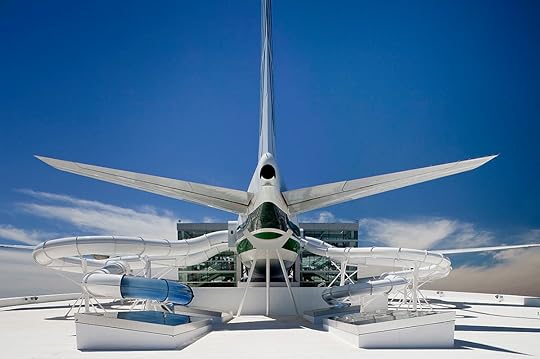
6
Boeing 747 - Evergreen Wings and Waves Waterpark, Oregon
Air-and-space museums were my absolute favorite when I was a kid. No number of classical Renaissance paintings could ever compare to seeing the Spirit of Saint Louis and the Lunar Lander, or walking through the inside of an actual space shuttle. But the Evergreen Aviation and Space Museum in Oregon has done all others one better—it’s got its own waterpark. The Boeing 747 water slide is crafted from a real retired airplane, and riders get a great view of the surrounding area as they follow the curves of the slide across the museum’s roof.
(Via)
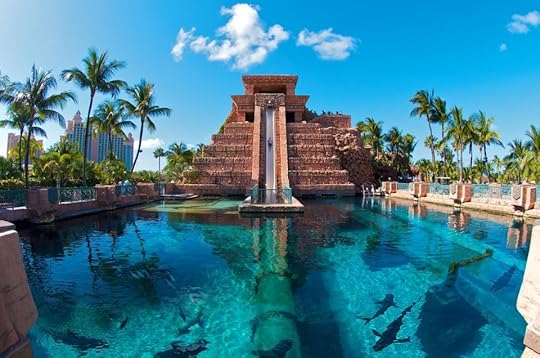
7
Leap of Faith - Atlantis Paradise Island, Bahamas
This might be my favorite waterslide on the list. Leap of Faith in the Bahamas begins at the top of a life-sized Mayan pyramid and propels riders over a 60ft freefall. The drop ends in a translucent, underwater tunnel, which travels through a one-of-a-kind shark-filled lagoon, in what has to be the single coolest aquarium experience of all time. (The company assures prospective riders that the sharks are not interested in chewing on the tunnel tube.)
(Via)
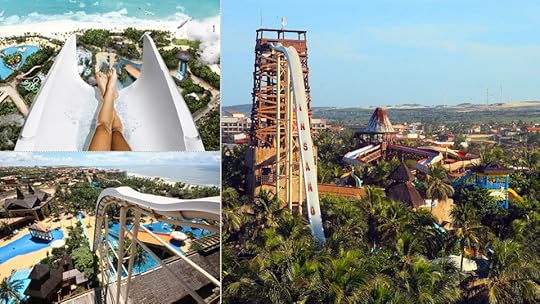
8
Insano - Beach Park, Brazil
Insano is the tallest, fastest waterslide ever built. It stands over 130 feet high, but the ride only lasts about four or five seconds because your body is rocketing back towards the earth at a brain-melting 65mph. Firsthand accounts say that the ride is so steep, and you’re moving so fast, that your body doesn’t actually make contact with the slide until you get to the bottom—you just fall through the air.
(Via)
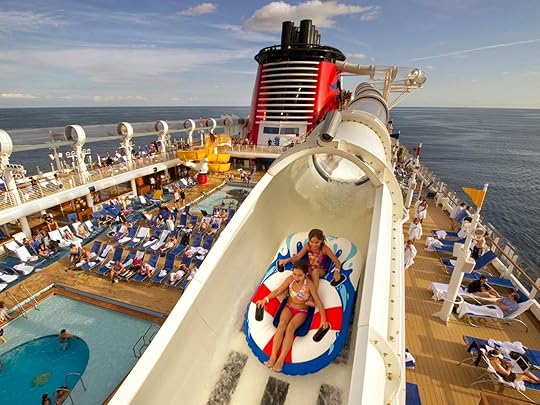
9
Aquaduck - Disney Cruise Ships
Thought it’s technically classified as a water coaster and not a waterslide, the Aquaduck is one of the most awesome rides on this list. Installed on several of the Disney Cruise ships, the ‘duck covers four decks and propels raft-riders up and over hills through crystal-clear tubing (which, at one point in the ride, extends 12 feet over the side of the ship, 150 feet above the open ocean).
(Via)
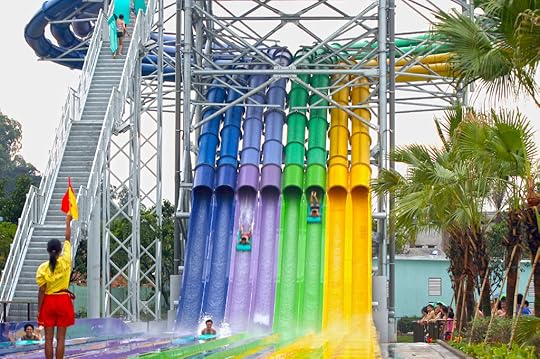
10
Head First Racer - Chimelong Waterpark, China
Eight identical side-by-side slides start 65 feet up, complete a full circle, and straighten out for a big splash-down following an arrow-straight drop. You just pick your favorite slide at the top and see if you can beat seven of your friends (or seven strangers, if none of your friends are brave enough to ride with you). As implied by the name, you ride this slide penguin-style.
(Via)
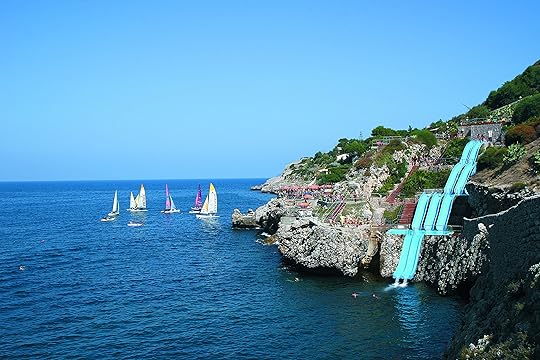
11
Toboggan - Città del Mare, Sicily
Let’s face it—most waterslides aren’t all that pretty. More often than not, they look like a circus clown’s balloon failure, all lumpy plastic and loop-the-loops. But not the Toboggan slide at the Città del Mare resort in Italy. Located on the coast of Sicily, this slide is the same bright blue as the ocean surrounding it. It descends three tiers of sheer, rocky cliffs before dropping riders into the sparkling waters of the Mediterranean.
(Via)

12
The Mammoth - Splashin’ Safari, Indiana
The Mammoth at Splashin’ Safari is aptly named—it is HUGE! The coaster itself covers over three acres and is the longest water ride in the world, but the raft ride is where it gets its massive reputation. First, you ride your little round boat up a seven-story ramp on a gigantic conveyor belt. Then you travel just under half a mile, over hills, through dark tunnels, and under the open sky.
(Via)
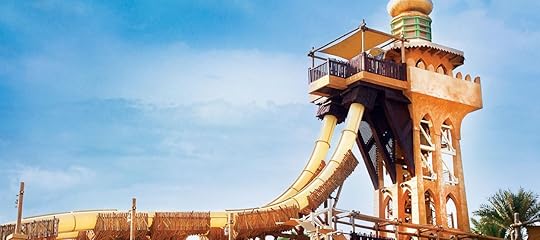
13
Jumeirah Sceirah - Wild Wadi Waterpark, Dubai
Jumeirah Sceirah, in Wild Wadi Waterpark in Dubai, was remodeled just this year and is one of the tallest and fastest vertical-drop waterslides outside of the US. From the 105ft tower, riders drop almost straight down and travel the full 350 feet of the slide in a matter of seconds, at top speeds of over 50mph. The slide tower itself is famed for its fantastic views of some of Dubai’s best-known structures, including the Burj Al Arab.
(Via)
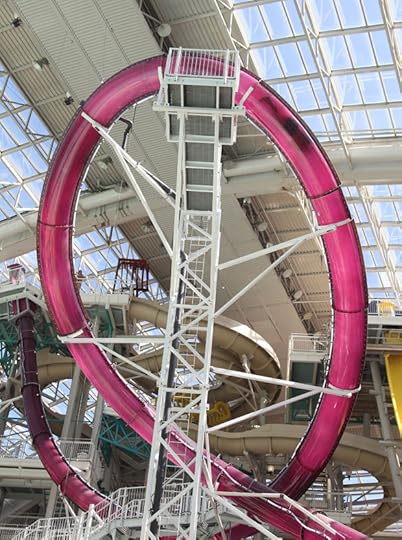
14
The Cyclone - World Waterpark, Canada
World Waterpark in Canada’s West Edmonton Mall is open year round, which must be nice when outdoor temperatures dip to 40 below. The Cyclone was the first slide with a 360-degree loop built in Canada, which has made it quite a popular attraction. It drops riders into a 55ft freefall before shooting them up into the nearly-vertical loop and then dropping them into the pool.
(Via)
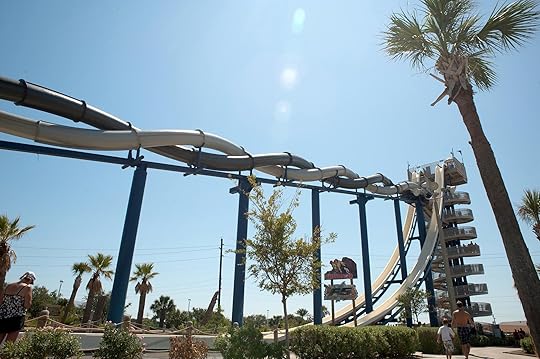
15
Cliffhanger / F5 Twin Twisters - Schlitterbahn, Texas
This pair of waterslides is as different as night and day. The Cliffhanger is an open-air, nearly vertical chute that plunges riders 80 feet toward the earth at speeds of up to 35mph before depositing them in the pool. The F5 Twin Twisters (currently being remodeled as the “Screaming Serpents”), are a pair of enclosed tubes that wind around one another like DNA, hurling riders through fog and lights on their way to the serpents’ mouths.
(Via)
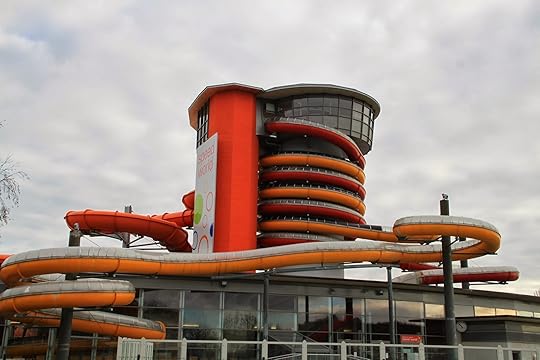
16
Twister and Speedy - Sonnentherme Lutzmannsburg Thermal Spa, Austria
These slides are evenly matched, though with different strengths: Speedy has, of course, speed, while Twister has distance. Speedy starts 75 feet in the air and traverses over 460 feet of tubing, while Twister is a little more gentle but extends over 660 feet. Plus, it’s pretty fantastical how they wind around that tower like big cartoon snakes.
(Via)
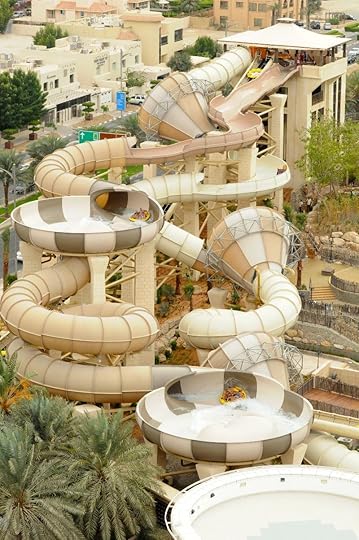
17
Tantrum Alley - Wild Wadi Waterpark, Dubai
Another ride from Wild Wadi in Dubai, Tantrum Alley was the first waterslide in the world to contain three funnels. Four-person rafts are subjected to two huge drops, and then tumbled in all directions in what the park’s website calls the “tornadoes.” As intense as that sounds, it’s not as scary as it looks, as those big striped bowls aren’t part of Tantrum Alley but instead belong to its sister slide, the Burj Surj.
(Via)
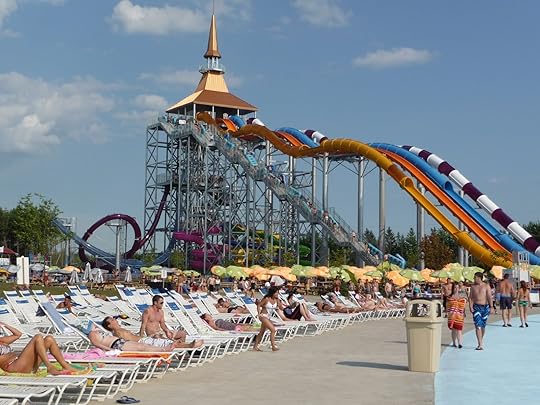
18
Summit Tower - Calypso Park, Canada
Another slide found in Canada, Summit Tower in Calypso Park is the tallest free-standing waterslide in North America. The tower provides the base for no fewer than 10 waterslides, all of which look totally amazing. Four slides known as the “Accelerators” start all the way at the top of the tower (90 feet up) and travel straight down over bumps and drops. Four more, called the “Family Twisters,” start at a friendlier 30ft height and wind their way back to the ground for a gentler ride. And finally, two matching and intertwined “AquaLoops” start 55 feet up and shoot the most daring watersliders through 360-degree loops.
(Via)

Matador Network's Blog
- Matador Network's profile
- 6 followers




